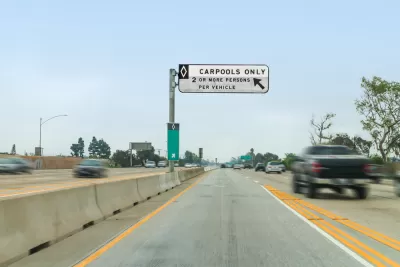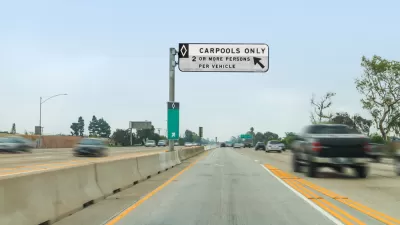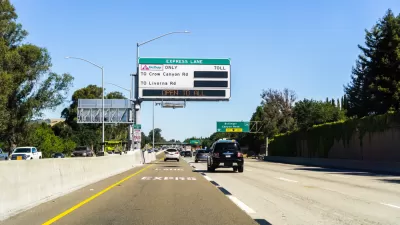Supervisors of California's fourth-largest county declared their formal opposition to the conversion of carpool lanes on the Riverside Freeway to high occupancy toll (HOT) lanes, but they are open to toll lanes, under the right conditions.

High occupancy toll (HOT) lanes, a popular form of express lanes where carpoolers are allowed free access, are inherently more efficient when managed with dynamic tolling than their older sister, the high occupant vehicle (HOV) lane, as they allow maximum utilization of the managed lane, by, in essence, 'selling' excess capacity to single-occupant vehicles. In other words, HOT lanes constructed by conversions enable increased capacity without widening highways.
However, in politics, efficiency isn't always the most important consideration, as illustrated by the 4-0 vote (with one member absent) by the Riverside County Board of Supervisors last Tuesday to approve a resolution by Supervisors Kevin Jeffries and Karen Spiegel to express "Support for Continued Utilization of Free HOV 2+ Carpool Lanes on SR 91 in the City of Riverside."
Retaining the "HOV 2+" threshold, meaning a minimum of two people – the driver and one passenger, constitute a carpool and are thus entitled free access on the HOT lane, is one of two conditions the board members insist upon before allowing single-occupant drivers tolled access to the 14 miles of managed lanes "from the current terminus on SR 91 near McKinley Avenue through Downtown Riverside and on to SR 60 in Moreno Valley."
A staff member from Supervisor Spiegel's office explained in a phone call that the current carpool lane was built with taxpayers' money and shouldn't be allowed to be converted to an express lane where three people would be necessary for free or discounted passage.
According to the resolution's background information, "current Riverside County Transportation Commission (RCTC) toll policies allow for a 50% reduction in tolls for vehicles with three or more occupants in Express Lanes during peak hours and free during 'off peak' hours."
The second condition was expressed by Supervisor Spiegel at the Sept. 10 board meeting. She said that the lanes "should not be converted to express lanes unless the toll fees are used to build more lanes to relieve traffic congestion," reported David Downey for The Press-Enterprise (source article).
"If we were adding capacity, I would feel different,” Spiegel said of the RCTC concept, reported NBC (Palm Springs) News.
“This is not adding capacity (to carry a greater number of vehicles). So we’re upset with this item, and now we go on record to oppose it.”
NBC News noted added that "[a]n additional lane would be constructed on both sides of the freeway solely for tolled express travel, regardless of the number of individuals in the vehicle." However, Jeff Greene, chief of staff for Supervisor Kevin Jeffries, explained by phone that's not a certainty, which the staff summary of the resolution confirms:
It is not certain that the proposed toll/express lanes for SR-91 will actually result in any additional capacity on SR-91. The only certainty from the proposed toll/express lanes is that additional fees will be paid by the motoring public.
Adding an express lane in each direction would indeed increase capacity, and costs, by $1 billion, according to NBC.
RCTC officials have stated publicly that the concept is in the nascent development stage and may never move forward, though the feasibility study will continue. Staff have cited the need for congestion relief on the 91 as a driving factor.
The county vote comes on the heels of an Aug. 20 vote by the Riverside City Council to also oppose the conversion of the carpool lanes to express lanes.
Both supervisors are not toll lane opponents – they supported the addition of new toll and general-purpose lanes on the 91 Express Lanes known formerly as the Corona Crawl that opened in March 2017 that connect with the lanes of the same name in Orange County.
Greene added that the RCTC has put on hold a study about conversions of HOV to HOT lanes, a move seen as a win by anti-tolling advocates. The last word may be up to the California Transportation Commission, according to NBC.
Lots of new road construction in Riverside County future
In his July 10 article on the RCTC's meeting, Downey lists what lies ahead, possibly contingent on a new sales tax measure that would go before county voters in November 2020.
- Inaugural pieces of Riverside County’s first new freeway in decades, the Mid County Parkway
- A third southbound lane connecting the 215 Freeway to the 15 Freeway in Murrieta
- Reconstruction of the 71/91 freeways interchange in Corona
- Extension of the 15 toll lanes south to Lake Elsinore
- New toll lanes on the 91 in Riverside [the subject of this post], 60 in Jurupa Valley, and 60 and 215 in Riverside and Moreno Valley.
Related in Planetizen:
-
Is the Era of the 'Free' Freeway Coming to an End? August 18, 2017
Hat tip Streetsblog California.
FULL STORY: Riverside County leaders oppose idea to turn 91 Freeway carpool lanes into toll lanes

Alabama: Trump Terminates Settlements for Black Communities Harmed By Raw Sewage
Trump deemed the landmark civil rights agreement “illegal DEI and environmental justice policy.”

Planetizen Federal Action Tracker
A weekly monitor of how Trump’s orders and actions are impacting planners and planning in America.

The 120 Year Old Tiny Home Villages That Sheltered San Francisco’s Earthquake Refugees
More than a century ago, San Francisco mobilized to house thousands of residents displaced by the 1906 earthquake. Could their strategy offer a model for the present?

Ken Jennings Launches Transit Web Series
The Jeopardy champ wants you to ride public transit.

BLM To Rescind Public Lands Rule
The change will downgrade conservation, once again putting federal land at risk for mining and other extractive uses.

Indy Neighborhood Group Builds Temporary Multi-Use Path
Community members, aided in part by funding from the city, repurposed a vehicle lane to create a protected bike and pedestrian path for the summer season.
Urban Design for Planners 1: Software Tools
This six-course series explores essential urban design concepts using open source software and equips planners with the tools they need to participate fully in the urban design process.
Planning for Universal Design
Learn the tools for implementing Universal Design in planning regulations.
Clanton & Associates, Inc.
Jessamine County Fiscal Court
Institute for Housing and Urban Development Studies (IHS)
City of Grandview
Harvard GSD Executive Education
Toledo-Lucas County Plan Commissions
Salt Lake City
NYU Wagner Graduate School of Public Service




























